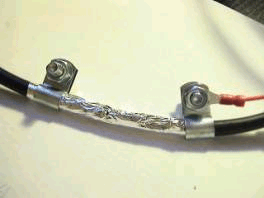Fitting an HT lead RPM pickup (DL1 MK1, DL1 MK2 and DL2 MK1 only)
The HT lead pickup method is not applicable to the DL1 SPORT, DL1 CLUB, DL1 PRO or DL2 MK2 high level RPM pickup inputs.
There are three methods for fitting the engine speed sensor to an HT lead. Start with the first method and, if there is not sufficient signal to trigger the logger, move onto the next setting.
- Attach the P-clip around the HT lead and to the ring terminal on the end of the red lead. Select the size of P-clip which grips the lead without squashing it.
- Remove the rubber lining from the P-clip and re-attach it to the HT lead, you may need to use a smaller P-clip for this. If it will not close enough to hold the clip in place on the HT lead, use some insulating tape to hold it in position.
- If there is still insufficient signal, place some aluminum foil underneath the P-clip to increase the surface area surrounding the HT lead. Hold the other end of the foil down with either another P-clip or some insulating tape. By varying the width of aluminum foil, it is possible to increase the sensor size.
The earth connection for the engine speed pickup must be attached to a suitable earth on the engine. Ensure that all wires are properly secured and that non will contact any moving parts or areas of extreme heat i.e. exhaust manifolds (headers)
There are a few important things to be aware of when using this method:
- Ensure that the sensor is not in contact with more than one HT lead, as this can cause false triggering. Also try to route the cable away from any other HT leads- again this can cause false triggering
- Keep the cable away from any hot parts of the engine (in particular the exhaust manifold)
- Connecting to the king lead generally gives a stronger signal than connecting to a plug lead, but this will limit the maximum engine speed which can be sensed
- If you experience problems with obtaining a reliable RPM signal, try disconnecting the earth wire from the engine. Ensure the loose wire cannot contain any moving part
- This method can only work when there is a spark to detect. Depending on how the coil is driven (mechanical points or ECU etc) the ignition may be cut by a rev limiter system, the traction control or when the engine is on over-run. If the ignition is cut you will get "straight lines" on the RPM graphs
- Again, depending on how the coil is driven the dwell time of the coil will change with engine speed and engine load. The longer the dwell time, the more power there is in the spark and the easier it is to detect. To make sure that you have a reliable RPM signal 100% of the time, you will need to test it over a variety of speed and load conditions
- The RPM ground must also be connected to both the logger and to a ground point near to the pickup. The ground connection is essential and if this is not done then the detected signal will be very poor.


